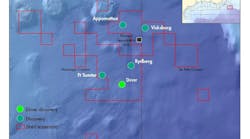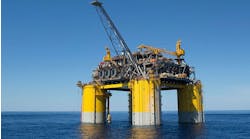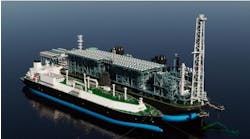Henry S. Pettingill,Noble Energy Inc.
Paul Weimer, University of Colorado
Exploration and production in deepwater (>500 m) has expanded greatly during the past decade, to the point that it has become a major component of the petroleum industry's annual upstream budget. Globally, however, deepwater remains an immature frontier, with many deepwater sedimentary basins lightly explored.
Deepwater discoveries account for less than 5% of the current world total oil-equivalent resources, although this amount is rising rapidly. These resources are predominantly oil and are concentrated in non-OPEC countries; thus, deepwater represents an important component of the world's oil equation. Deepwater gas exploration is extremely immature, reflecting current infrastructure and economic limitations, but destined to become a major future focus. Despite the rapid emergence of deepwater, most of the activity has been concentrated within only three areas of the globe, leaving large portions of the world's deepwater margins lightly explored.
Although the global deepwater play was initially restricted to a few large majors, progressively smaller companies have become involved, to the point where most large or medium-sized companies must understand the geological, engineering, and economic characteristics of the play. Generally, smaller companies are exploring in areas where:
•A major infrastructure already exists, and consequently they are able to operate
•They can be a partner with limited working interest, thus limiting their financial risk while still exposing themselves to possible high rewards.
Discovered resources
Approximately 58 Bboe total resources have been discovered in deepwater from 18 basins on six continents. This total consists of 39 MMbbl of oil and condensate and 112 tcf of gas. More than half of this total has been discovered since 1995, but only about 25% of the total resources are developed or currently under development and less than 5% have been produced, underscoring the play's immaturity. Most resources have been found in the Gulf of Mexico, Brazil, and West Africa.
The global deepwater exploration success rate was about 10% until 1985, but has since averaged 30%, driven by remarkable success in the Gulf of Mexico and West Africa. Exploration success rates have been highest in West Africa and lowest in Asia. In the Lower Congo basin, the geological success rate over the past few years has exceeded 80%.
Since deepwater drilling started in the late 1970s, 33 giant discoveries (>500 MMboe recoverable) have been made in deepwater. Of the 58 giants of the decade 1990-1999 that were true wildcats, roughly one-third were found in deepwater. Whereas the total number of giant fields discovered worldwide in recent decades has leveled off, the discovery rate of deepwater giants is rapidly increasing. Associated deepwater giant reserves are 66% oil, compared to 36% oil for all giants of the same time period.
Although OPEC accounts for almost 80% of the world's current oil reserves, it accounts for only 17% of the deepwater oil resources, all from the waters of Nigeria and Indonesia. Members of the Organization for Economic Cooperation and Development, in contrast, account for only 8% of current oil reserves, but hold 27% of current deepwater oil resources discovered to date. In terms of gas resources, the OECD accounts for 73% of the deepwater resources reported to date, as opposed to only 9% of the total current gas resources. Deepwater is a frontier with relatively more resources for the OECD, particularly when considering the gas fraction of the total deepwater resources.
Deepwater geology
The various basin settings that host the world's deepwater exploration and production frontiers are classified as confined and unconfined. Most active deepwater exploration areas are located along passive margins, down-dip from productive Cenozoic delta systems, where depocenters are confined and partitioned by "mobile substrate" – salt and shale. Both extensional and contractual domains exist within these mobile substrate basin settings. A large majority of the hydrocarbon resources discovered to date in deepwater are found within such areas that are depositionally confined by mobile substrate.
The potential for source rocks is good in deepwater. World-class source rocks have been found in Jurassic, Cretaceous, and Tertiary strata and have sourced the majority of deep-water resources. Potential oil source rocks for deepwater plays are both continental and deep marine in origin. Deepwater areas downdip from productive large delta systems have been found to have robust charge systems, often with the same source rocks as in shallow water, but sometimes with additional marine source units also present.
Oil quality in the world's deepwater basins is variable, even locally in some basins. This variable quality can be a development concern, especially in ultra deepwater, where there is less overburden to mature source material.
In most deepwater areas explored to date, there is enough disseminated organic matter in the sediments to generate large volumes of biogenic gas. In areas where infrastructure allows economic gas extraction, therefore, there is an excellent chance of economic quantities of gas charge.
Because source rocks in most of the major producing regions have only recently become mature, timing is often a minor risk in deepwater. Migration routes into traps are sometimes straightforward, via adjacent depocenters and faults. In some regions, however, migration can be more problematic.
Successful exploration of deepwater plays has depended on critical geological and geophysical techniques, including seismic amplitude-versus-offset and other direct hydrocarbon indicators, pre-stack depth migration imaging, understanding pore pressure, and prediction of thick, highly-connected permeable reservoirs.
Reservoirs
Most deepwater reserves have been discovered in Cenozoic age reservoirs, although there is a modest but growing contribution from Cretaceous reservoirs. Almost 90% of the resources found to date are within turbidite sandstone reservoirs, but there is a small contribution from shallow-marine and fluvial sandstone reservoirs, and a minor contribution from carbonates. Porosity and permeability in turbidites are often excellent, but reservoir architecture (connectivity and continuity) ranges from poor to excellent, with low net/gross channels and levees being more difficult to develop economically. Therefore, pre-drill predictive capability for these reservoirs is critical.
Trap styles vary
Trap types can be lumped into three broad categories: Pure structural traps, pure stratigraphic traps, and combination traps. Combination traps are those that depend on both a structural trapping element (fault, anticline, or diapir flank) as well as a stratigraphic component (pinchout or truncation). Using the giant deepwater discoveries for which trap information is published, we can approximate the relative resources associated with these three categories. While pure stratigraphic traps are relatively infrequent in deepwater, roughly two-thirds of the deepwater resources are found in traps that have a stratigraphic component. This reflects the fact that turbidites are the predominant reservoir type of deepwater discoveries, and those reservoirs commonly have stratigraphic trapping components.
Topseal
In the deep marine depositional environment, adequate topseals are generally present. Topseal integrity, on the other hand, is often a serious risk, due to overpressures, crestal faulting, or shallow burial depths. Understanding the relation between reservoir pressure, overburden pressure, and rock strength is critical. In Nigeria, Brunei, and the northern GoM, some accumulations are more aptly described as "imperfect leaks" than perfect traps.
When a component of stratigraphic trapping is required, the presence of a side-seal can also introduce risk, especially in the case where the updip axis of a feeder channel is required to seal. Relatively few fields are documented with this trap component; although several exist in the eastern GoM Cenozoic, of which Ram Powell is the best documented.
Field sizes
Deepwater field sizes (ultimate recoverable resources) are highly variable from one basin to the next. The large differences in mean field size reflect differences in trap area and net feet of pay, and, to a lesser extent, recovery factor. In the confined basin setting, which is often composed of small minibasins, fields often have large net pay values but limited trap areas, e.g., the supra-salt areas of the northern Gulf of Mexico. In contrast, the Campos basin has less confinement between salt bodies, and trap areas can be quite large, leading to a larger mean field size. To date, traps in deepwater Nigeria and Angola tend to be rollover anticlines or diapir flanks having large area, often accompanied by stacked sand sequences of high net pay, leading to large field sizes.
Established trends
Most of the world's established deepwater play areas are at a relatively immature state of exploration; therefore, continued success within those proven plays is almost a certainty. Some basins with substantial shallow water production lack substantial deepwater reserves. In some areas such as Southeast Asia, deepwater is moderately leased, yet reserves found to date are modest, partially due to low drilling density. Most of the Asian deepwater plays are gas-prone, even those containing oil, and this has limited drilling.
Emerging trends
Going beyond the established geological formula, exploration is extremely immature within basins lacking updip production, within unconfined basins and compressive margins, and in plays with pre-Cenozoic and non-turbidite targets. Some classic compressive continental margins have had recent leasing and seismic activity, such as those in southern Italy, Mexico, Cuba, and southern Argentina.
Deepwater gas exploration should increase, as pipeline networks and liquefaction technology advance, in conjunction with increased worldwide consumption. Many of the world's deepwater basins are gas-prone, but many of those currently lack markets.
Going deeper
Currently, GoM deepwater exploration wells routinely have total depths exceeding 6,000 m, while relatively few exploration wells in other deepwater frontiers have drilled beyond 4,000 m total depth. Sub-salt objectives occur in several deepwater basins around the globe; however, only the Gulf of Mexico has seen deepwater subsalt drilling, and at least one subsalt structural trend there has been leased but not drilled.
Political openings
Finally, new opportunities may arise in areas previously not open due to monopolies, moratoriums, and boundary disputes. In Brazil, the removal of a monopoly has resulted in sequential offerings of prospective deepwater areas for licensing. The Eastern GoM has had a 10-year leasing moratorium, despite the proliferation of deepwater discoveries along its border, but was partially reopened with a leasing round late this year. Also in the Gulf of Mexico, the ultra-deepwater "donut hole" area between Mexico and the US has been resolved, and the US portion was recently opened for leasing.
Global exploration in deepwater settings has significantly increased during the past decade, adding 58 Bboe discovered. Globally, deepwater remains an immature frontier, accounting for less than 5% of the current world-wide total oil-equivalent resources. Only about 20% of the discovered deepwater resources are developed, and less than 5% have been produced.
Most of the exploration activity has been concentrated within only three areas of the globe, with a majority of the discovered resources in the GoM, Brazil, and West Africa. Consequently, large portions of the world's deepwater margins remain lightly explored. Deepwater gas exploration is extremely immature, reflecting current infrastructure and economic limitations, but destined to become a major future focus.
The petroleum systems of deep-water margins are highly variable between different basins. Successful exploration efforts will depend on understanding the differences both within and between basins.
Most reservoirs in deepwater are associated with turbidites, although in some basins, shallow water carbonates and siliciclastics are potential reservoirs. Trapping styles vary considerably in the deepwater associated with faulting, salt, and shale deformation, and compressional features. Pure stratigraphic traps are rare, but many traps have a stratigraphic component, and some are reduced or enlarged by a stratigraphic pinchout. Adequate seals are present due to the dominance of shale in these basins, although potential leakage can be a significant risk.
Conclusions
Five main themes will drive deepwater exploration in the future:
- A continuation of established trends
- Emerging trends include basins that lack updip production, unconfined basins, compressive margins, pre-Cenozoic targets, non-turbidite targets, and non-seismic direct hydrocarbon indicator targets
- Increased exploration specifically for gas
- Going deeper: Ultra-deepwater and deeper drilling
- Politically-driven opportunities.
Acknowledgments
The original version of this paper is based on a keynote address presented at the 2001 GCSSEPM Research Conference on the Frontiers of Deep Water. We would like to thank IHS Energy for use of selected data and the many geoscientists and engineers, too numerous to list here, that have presented papers on deepwater at recent conferences, from which many of the ideas presented herein have been developed.
Editor's Note: This is a summary of OTC 14024.







